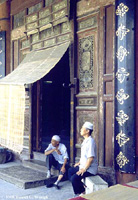
Ming dynasty, early 17th century CE
Xian, Shaanxi Province, China
Photo copyright © Daniel C. Waugh, 1998
It was in the Ming period that the large Muslim community in Chang-an (modern Xian) really took root and its members became largely sinicized. Muslim merchants had arrived in great numbers in China as early as the Tang era through the ports of the South China coast and through the Silk Route from Central Asia, but had been required to live in segregated communities. By the sixteenth century, however, we know that many of the Muslims living in China apparently knew little Arabic or Persian, and their families had practiced the religion for generations.
While it is claimed that the Great Mosque (Qingzhen Dasi) of Chang-an (modern Xian) was first built in 742, there is some doubt as to whether it or any other mosques in Chinese cities are of such antiquity. The buildings seen today inside the mosque compound date from the late Ming period, such as the entrance gate which was erected in 1600-1629. In its arrangement of courtyards and purely Chinese-style architecture, the mosque is visual evidence of the degree to which there was a syncretism of Islam and at least some of the externals of Chinese culture. The Inscription on the "One God Pavilion" is the Muslim declaration of faith, "God is One," rendered in Chinese characters. The mosque is situated not far from the location of the western market whose merchants played an important role in the continuing trade of along the Silk Route through the Hexi corridor into the Western Lands during the Ming and Qing eras.
-- Daniel Waugh
For more information on the Great Mosque at Xian, see the Xian/Chang-an pages on the Silk Road Seattle web site.






